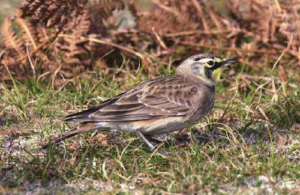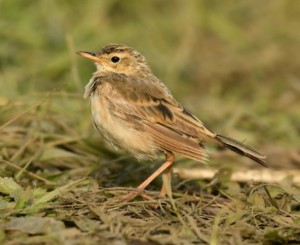Changes to the British List (18 January 2022)
The British Ornithologists’ Union Records Committee (BOURC) has made the following decisions with regards to the British List:
New first record
 North American Horned Lark (alpestris group) Eremophila alpestris (alpestris/praticola/hoyti)
North American Horned Lark (alpestris group) Eremophila alpestris (alpestris/praticola/hoyti)
One, first-calendar-year or older, Isles of Scilly, 2-31 October 2001: Periglis, St Agnes (2 October), Carn Near, Tresco (9-18 October), Wingletang Down and Covean, St Agnes 20-23 October, and Carn Near and Pentle Bay, Tresco (29-31 October).
Photo (right) © Mike Malpass (from the record file), October 2001
This record pre-dates the previously accepted first record of the subspecies group, and is therefore accepted as the first British record.
Place in Category D
 Paddyfield Pipit Anthus rufulus
Paddyfield Pipit Anthus rufulus
One, first-calendar-year or older, Sennen, Cornwall,
23 October to 14 November 2019.
Photo (right) © Steve Rogers (from the record file), 4 November 2019
This extraordinary and unexpected record resulted in a protracted and detailed examination by the Committee.
The identification as Paddyfield Pipit was confirmed by a combination of detailed field notes, photographic images, analysis of vocalisations and DNA evidence: the record likely pertains to the nominate subspecies A. r. rufulus.
However, the provenance of the individual was far less clear. Paddyfield Pipit is a largely non-migratory tropical Asian species with no Western Palearctic records, for which there are only records of short-distance vagrancy as far as the Arabian Peninsula. No other species with a similar distribution or life history has been observed as a vagrant to Britain. The species has also been documented in the wild bird trade, at least in South East Asia. Human-transport of a wild bird, including via aircraft, as has been documented in an increasing number of species, was also considered to be a possibility. Unusual feather damage was noted on the bird which might be suggestive of captive origin, but comparable wear has been documented in similar species of wild origin.
Combined, these reservations resulted in the Committee placing the record and the species in Category D by a majority vote, which will allow the record to be reviewed in the future when more is known about the species’ potential incidence as a vagrant to Europe. A paper describing in more detail the process taken by BOURC to come to this conclusion will be published in British Birds.
These decisions will be published as part of the BOURC’s 54th report due to be published in IBIS in July 2022.
Upon publication of these changes, the British List stands at 628 species (Category A = 610; Category B = 8; Category C = 10).

